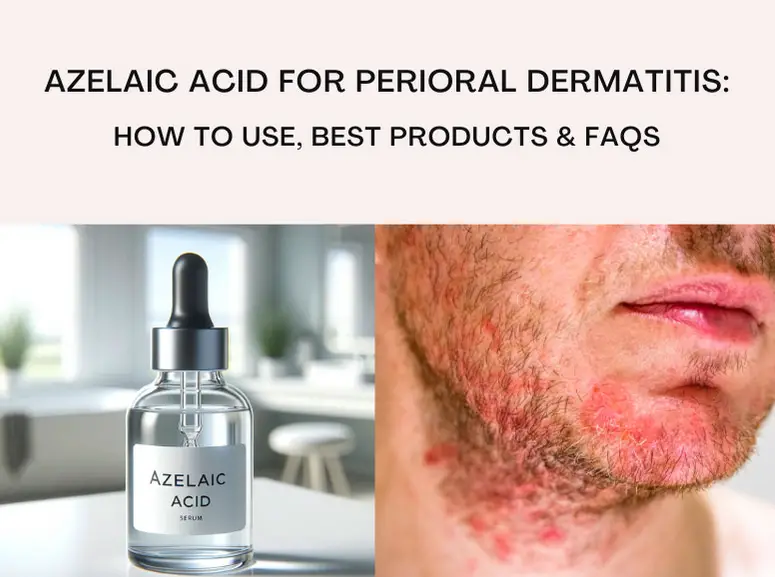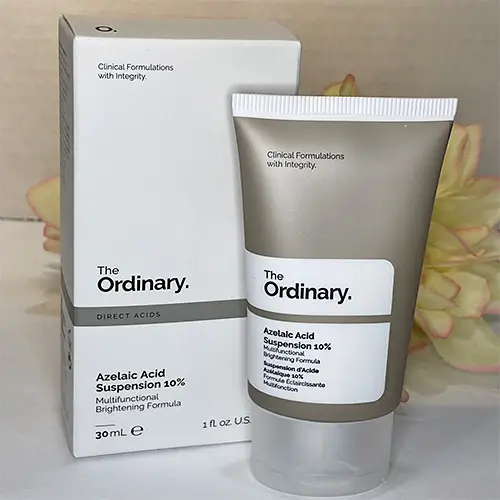
If you wake up one morning with tiny red bumps around your mouth this may be a sign you are suffering from perioral dermatitis. This inflammatory skin condition is a widespread condition experienced by women and children.
Although common, its cause is still unknown to science and possible topical treatments include azelaic acid. Azelaic acid is a naturally occurring acid that is used in skin care for its antimicrobial and anti-inflammatory properties.
In this post, we discuss how it can be used for the treatment of perioral dermatitis.
Disclaimer: This post contains affiliate links which means I may get a small commission if you purchase a product after clicking on a link. This does not cost you anything. As an Amazon Associate, I earn from qualifying purchases.
How azelaic acid can help perioral dermatitis
Azelaic acid is a dicarboxylic acid derived from plants like wheat, rye, and barely. It is used as a treatment for perioral dermatitis for the following reasons:
It is antioxidant and anti-inflammatory
Perioral dermatitis can be triggered when the skin comes in contact with irritants like steroid-based inhalers or creams, harsh soaps, fragrances, dyes, strong skincare actives (like exfoliants, retinol, benzoyl peroxide) or even fluoridated toothpaste. These tend to cause inflammations on the skin.
Azelaic acid is known to have profound antioxidant properties that help neutralize oxidative stress which can negatively impact the skin cells and disrupt the skin’s barrier.
Its anti-inflammatory properties, on the other hand, help to soothe already present inflammation on the skin and prevent further irritation.
It improves skin texture
Perioral dermatitis usually causes dry, flaky, or scaly patches to form on the skin around the mouth and nose. This causes the skin to develop a rough and unpleasant texture.
One of the benefits of azelaic acid is that it equally has an anti-keratinizing effect. This means that it reduces the excess build-up of skin cells in the affected areas which causes the skin to become rough and scaly.
Its gentle exfoliating properties help break down excess dead skin cells present on the skin without causing further irritation to the contaminated area. This benefit is also one of the reasons why azelaic acid is recommended for the treatment of other inflammatory disorders like acne and rosacea.

How to use azelaic acid for perioral dermatitis
Most azelaic acid treatments come in the form of topical creams which can be applied to the skin directly. These may be in a skincare emulsion or serum, or a prescription-strength OTC cream. Whichever it is, azelaic acid can be applied twice a day (ie morning and night).
When introducing azelaic acid to your skincare routine make sure to apply it after your hydrating and brightening serums and before your moisturizer.
If you have sensitive skin or are just worried it might irritate your skin, you can apply it after your moisturizer for a few days or a week. This technique helps buffer the effect of azelaic acid until your skin gets used to the product.
You want to make sure that you are using a very good moisturizer that contains barrier repair ingredients such as peptides, ceramides, essential fatty acids and humectants. This will help prevent any dryness that may occur as a side effect of using azelaic acid.
The great thing about azelaic acid is it pairs with most actives and can be used even after your perioral dermatitis flares up to help brighten your skin.
Best azelaic acid products for perioral dermatitis
If you are now excited about trying azelaic acid then here is a list of some of the best azelaic acid skincare products on the market. These range from creams, and gels, to serums:
- The Ordinary Azelaic Acid 10% Emulsion
- Naturium Azelaic Topical Acid 10%
- Paula’s Choice BOOST 10% Azelaic Acid Booster
- Facetheory Lumizela Azelaic Acid Serum A15
- Typology Mattifying Serum 10% Azelaic Acid
- Oleogel R
FAQs
How long does azelaic acid take to work on perioral dermatitis?
There is no fixed time frame to expect results but you should be looking at a couple of weeks at least to start seeing significant results. However, perioral dermatitis is known to respond rapidly to treatment except in the case of a chronic breakout or an infection of the affected area.
Also note that because perioral dermatitis occurs as the skin’s reaction to a trigger, finding out what triggers your flare-ups is the first step to see quicker results.
Can azelaic acid make perioral dermatitis worse?
No, azelaic acid will not make your perioral dermatitis worse. It is recommended as a front-line topical treatment for this condition alongside other antibiotic creams like metronidazole cream/ gel, or clindamycin lotion. However, this treatment presents the risk of an allergic reaction, especially for very sensitive skin types.
Can azelaic acid cause perioral dermatitis?
Absolutely not. Azelaic acid does not trigger perioral dermatitis flare-ups. However, there is a risk of irritation when using this acid.
Common side effects linked to the usage of azelaic acid include; itching, burning, tiny rashes, redness, swelling of the skin, and tightening or drying of the skin.
Must azelaic acid be prescribed for me to use?
Although your doctor can prescribe you an azelaic acid cream or gel to treat your flare-ups, it is not a must. If your skin is prone to flare-ups and you can identify when a breakout occurs using a skin care product with a high percentage (15%) of azelaic acid will help you calm things down.
Related articles:
Treating Perioral Dermatitis during pregnancy
How to get rid of perioral dermatitis using Aloe vera
The Ordinary Products for Perioral Dermatitis

Petra Nakashian (previously Kravos) is a dedicated natural health and beauty blogger, driven by the loss of her parents to cancer, which led her to meticulously research beauty product ingredients. With over 10 years of experience, her in-depth knowledge has made her a trusted expert in the field. Founder of Be Healthy Now and Green Beauty Talk, Petra recently expanded her expertise with Beauty Insights Hub, exploring a wider range of beauty treatments. Committed to transparency and honesty, her work is a vital resource for navigating the complex world of beauty.

